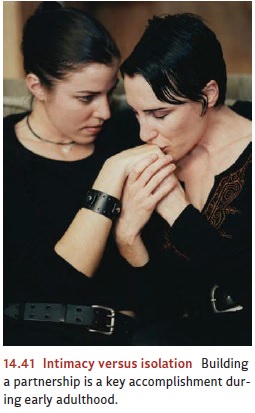Chapter: Psychology: Development
Socioemotional Development in Adulthood
Socioemotional Development in Adulthood
When
we are told that Will is 2 and Sarah is 10, we can make pretty good guesses
about each of their socioemotional concerns. Will is likely to be newly mobile,
upset when separated from his mother, and good at saying no. Sarah is likely
focused on peer acceptance and school performance and may be facing the onset
of puberty. However, when we are told that Eduardo is 42 and Leticia is 50, we
are much less certain what their socioemotional concerns will be. Are Eduardo
and Leticia single, or married? Does either of them have children? If so, are
the children still living at home? In school? Working? If Eduardo and Leticia
work, do they have low-level positions, or are they CEOs of companies they have
founded? If they don’t work, have they already retired, or are they still in
school? As these questions suggest, socioemotional concerns are linked with age
much less in adulthood than in any prior stage. Nonetheless, some broad
patterns are evident in adults’ socioemotional goals and challenges.
THE STAGES OF ADULTHOOD
As
we saw earlier, Erikson provided an 8-stage model of life-span development.
Four of these stages relate to infancy and childhood, one stage relates to
adolescence, and the remaining three stages relate to adulthood. These
adulthood stages are concerned with intimacy
versus isolation (20s through early 40s), generativity versus stagnation (40s to60s), and integrity versus despair (60s to death).
The major concern during the intimacy versus isolation stage is developing an intimate relationship. Whether an individual’s romantic relationship is heterosexual or homosexual, the key accomplishment of this stage is building a partnership (Figure 14.41; Peplau & Fingerhut, 2007). Often, these close relationships lead to mar-riage, and as discussed, the passionate love that characterizes early romance grows into companionate love. Sometimes, close relationships lead to having or adopting children and to building a family. Many find that this is the biggest life transition of all. Becoming a parent requires large changes in work, hobbies, and per-haps most of all, one’s primary relationship. Researchers have found that couples’ mar-ital satisfaction typically drops with the birth of their first child but rebounds once the children reach school age (Cowan & Cowan, 2000).

In
contrast to the relationship goal of
the intimacy versus isolation stage, the goal of the generativity versus stagnation stage concerns work, broadly
defined. For some, the work that they do is merely a job—a means of earning a
paycheck. For others, their career forms an important part of their
self-identity. When asked who they are, they respond by saying what they do (“I
am a doctor” or “I am a lawyer”). For others still, the work that they do is a
calling—something they feel compelled to do and would do even if they weren’t
paid (Wrzesniewski, McCauley, Rozin, & Schwartz, 1997).
No
matter what form their work takes, though, people are generative, in Erikson’s
view, to the extent that they contribute to the next generation and, more
generally, to causes that will outlive them. Generativity can include teaching
students, or training a new generation of executives. It may take the form of
raising children, or of volunteer activities, such as working in a soup
kitchen, coaching a soccer team, or volunteering as a docent in a museum.
AGE – RELATED CHANGES IN WELL - BEING
Before
we turn to the last of the crises Erikson describes, we need to deal with a
sepa-rate issue, often mentioned in discussing the adult years. This is the
so-called midlifetransition (or,
sometimes, the midlife crisis), the
point (according to conventional wis-dom) at which adults reappraise what they
have done with their lives thus far and may reevaluate their marriage and
career (Wethington, 2000; Willis & Reid, 1999). It is a period when
individuals begin to see physical changes that show that the summer of life is
over and its autumn has begun, a recognition that may occur earlier in women
than in men (in part because of the psychological and physiological impact of
menopause). There is a shift in the way one thinks about time, from “How long
have I lived?” to “How much time do I have left?” This is thought to prompt
some people (especially men) to get hot new cars and seek younger playmates to
reassure themselves (and the world) of their virility and power (Figure 14.42).

What
do the data tell us about this period of apparent turmoil? Contrary to
conven-tional accounts, depression, anxiety, and emotional instability do not
appear to change throughout the 40s (McCrae & Costa, 2003; Mroczek &
Kolarz, 1998). People do, of course, have emotional crises at various points,
including their 40s. However, such emotional crises do not appear to be
particularly more likely in the 40s than at other points in the life span.
It
seems, then, that a midlife crisis is far from inevitable. One further
crisis—and the third in the series Erikson associated with adulthood—is,
however, inevitable, because it is linked to the fact of eventual death.
Erikson described this stage as revolving around the polarity of integrity versus despair. In this
stage, the individual looks back on his or her life and considers what it has
all meant. If she is able to find meaning in the life she has lived, she is
said to have achieved integrity and may come to some sense of peace with her
life. By contrast, if a person looks back on life with feelings of regret and
disappoint-ment about missed opportunities, he is said to have fallen into
despair.
A century ago in the United States, various support systems within the family, or within one’s neighborhood, made this transition appreciably easier. Different genera-tions often lived close together as an extended family, and there was much less segrega-tion by age. Nursing homes and retirement communities were unheard of. Older people contributed to the family even when they were too old to work outside the home. They cared for the children, helped with the housekeeping, and so on. Older people were also sought out for advice on matters of child rearing and housekeeping. But today, it is less common for the elderly to have such a recognized family role. They usually live apart from their family, are effectively segregated from the rest of society, are excluded from the workforce, and have lost their role as esteemed advisers. Given these changes, it follows that the transition into senescence is quite different in the United States from what it was 100 years ago—the elderly now seem less esteemed and are certainly more isolated.
These
points seem to suggest that old age would be a sorrowful time. Surprisingly,
though, this hypothesis is wrong, and, in fact, pos-itive feelings seem to be
greater in older age than in earlier periods (Mroczek, 2001). What produces
this pattern? According to Laura Carstensen’s socioemotional-selectivity theory (2006), because of their
shrinking time horizon, older adults increasingly value emotional goals
(feeling good rather than bad) over informational goals (learning new things),
and this leads to maintained or even increased levels of positive emotion.
Older adults also report being able to better control their emotions than
younger adults (Gross et al., 1998). These reports are borne out by the finding
that older adults attend to negative aspects of their environments to a lesser
degree than younger adults (Mather & Carstensen, 2003). Thus, despite the
losses that older
adults
face, these data tell us that they enjoy comparable—or even enhanced—levels of
well-being, which is good news indeed for all of us who aspire to live to a
ripe old age.
Related Topics